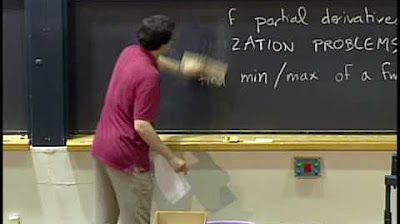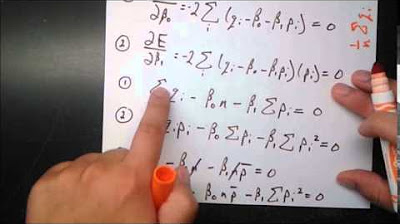7.5 Fitting via Interpolation
TLDRThis video script delves into the concept of data fitting, particularly interpolation, and its significance in handling large datasets. It introduces the problem of finding values between given data points and discusses polynomial fitting, emphasizing the importance of keeping fits local to avoid unrealistic oscillations. The script also covers spline fits as a smooth alternative and introduces the mathematical approach of Lagrange interpolation. It concludes with a caution against extrapolation due to its unreliability and encourages viewers to explore spline fitting through provided applications and applets.
Takeaways
- 💡 Computers are especially valuable for handling large amounts of data and can perform interpolation on datasets.
- 📊 Interpolation is the process of estimating a value between known data points in a dataset.
- 📈 Plotting data is a good practice for visualization and understanding trends before performing interpolation.
- 🔍 Interpolation can transform a table of numbers into an analytic function that can be used in equations.
- 📚 Polynomial fitting is a common method for interpolation, but it's important to avoid overfitting with high-degree polynomials.
- 📉 High-degree polynomials can lead to unrealistic oscillations between data points, which may not be scientifically reasonable.
- 🔑 Spline fitting is a smooth interpolation method that is often used in graphics and provides a visually pleasing curve.
- 🔍 Splines are piecewise polynomials where the polynomials are fitted to small segments of the data with continuous first and second derivatives.
- 🛠 The term 'spline' comes from a flexible drawing tool used to create smooth curves by hand.
- 📝 Lagrangian interpolation provides a closed-form expression for a polynomial that fits a set of data points.
- ⚠️ Extrapolation should be used with caution as it involves predicting data beyond the known dataset, which can be unreliable.
Q & A
What is the main topic discussed in the video script?
-The main topic discussed in the video script is data fitting, with a focus on interpolation techniques for handling and analyzing data, particularly when dealing with large datasets.
Why are computers particularly valuable in the context of data fitting?
-Computers are particularly valuable in data fitting because they can efficiently handle large amounts of data and perform complex calculations required for interpolation and fitting models to the data.
What is interpolation and why is it necessary?
-Interpolation is the process of estimating unknown data points within the range of a known set of data points. It is necessary when one needs to determine a value that falls between listed entries in a dataset.
What is the difference between interpolation and a best fit to data?
-Interpolation is about estimating values between known data points, while a best fit to data is a statistical approach that tries to incorporate errors and find a model that best represents the entire dataset, not just interpolate between points.
Why is plotting data a good idea when analyzing it?
-Plotting data is a good idea because it helps in visualizing trends, patterns, and anomalies within the data, making it easier to understand and interpret the information.
What is the problem with using high-order polynomials for fitting data?
-High-order polynomials can fit the data points exactly but may result in unrealistic oscillations between the points, which can be scientifically unreasonable and not reflect the true nature of the data.
What is a spline fit and why is it considered smooth?
-A spline fit is a type of interpolation method that uses piecewise polynomials to fit the data. It is considered smooth because it ensures continuity in the function and its first and second derivatives, resulting in a visually pleasing curve without unrealistic oscillations.
What is the origin of the term 'spline' in the context of data fitting?
-The term 'spline' comes from a flexible drawing tool used to create smooth curves. In data fitting, it refers to the smooth curves generated by the piecewise polynomials that connect data points without sharp turns or oscillations.
What are the conditions for a natural spline?
-A natural spline has conditions where the second derivatives (curvature) vanish at the end points, meaning there is no artificial bending or curvature beyond what the data points suggest.
Why is extrapolation using fitted models risky?
-Extrapolation using fitted models is risky because it involves predicting data points beyond the range of the known data. Without data points to constrain the model, the predictions can become unreliable and may not accurately represent the true behavior of the data.
What is the significance of the Lagrange interpolation formula mentioned in the script?
-The Lagrange interpolation formula provides a closed-form expression for finding the value of a function at any point within a given range of data points. It is significant because it allows for exact polynomial interpolation of a dataset, although it is best used for small datasets due to its complexity.
How does the cubic spline method ensure the continuity of the first and second derivatives?
-The cubic spline method ensures the continuity of the first and second derivatives by fitting a third-degree polynomial to each interval between data points and then matching the values and derivatives at the boundaries of these intervals, creating a smooth transition between segments.
Outlines
📊 Data Fitting and Interpolation Basics
This paragraph introduces the concept of data fitting, specifically interpolation, which is the process of estimating values between known data points. It emphasizes the utility of computers in handling large datasets and mentions the importance of plotting data for visualization. The speaker outlines the goal of converting a table of numbers into an analytic function through interpolation, which can then be used in equations. The paragraph also introduces the task of determining the peak and full width at half maximum of a given dataset, which will be explored further in subsequent lectures.
📈 Polynomial Fits and Their Pitfalls
The second paragraph delves into polynomial fitting, explaining how a polynomial of order 'n' can be used to fit 'n' data points. It cautions against the overuse of high-degree polynomials, which can lead to unrealistic oscillations between data points. The speaker introduces the concept of a spline fit as a smoother alternative and warns against the misuse of polynomial fits for extrapolation beyond the dataset. The paragraph also touches on the historical development of endpoint Lagrange interpolation, providing a mathematical formula for fitting an 'n-1' degree polynomial through a set of data points.
🔍 Implementing Endpoint Lagrange Interpolation
This paragraph provides a step-by-step example of how to apply the endpoint Lagrange interpolation formula to a set of four data points, resulting in a cubic polynomial. It demonstrates the process of calculating the polynomial coefficients and verifying the fit by evaluating the polynomial at one of the data points. The speaker highlights the ease of programming this formula and its reliability for fitting small datasets, while also cautioning against its use with large 'n' values.
🌐 The Appeal and Application of Cubic Splines
The fourth paragraph discusses cubic splines, a popular method for creating smooth curves that fit a set of data points. It explains how cubic splines work by fitting a third-degree polynomial to each interval between data points, ensuring continuity of the first and second derivatives. The speaker provides a visual analogy of a physical spline tool used for drawing smooth curves and mentions the availability of software tools for implementing spline fits. The paragraph also outlines the mathematical process of setting up and solving the equations required for cubic spline interpolation, including the handling of boundary conditions.
🛠️ Spline Implementation and Its Limitations
The final paragraph provides an overview of how to implement spline fits using a computer program, detailing the steps involved in matching function values and ensuring continuity of derivatives at adjoining intervals. It explains the use of natural spline conditions, where the curvature vanishes at the endpoints, and presents a simplified view of the code required for spline fitting. The speaker advises caution when using splines with noisy data, as the method should not fit the noise but rather the underlying trend, and concludes with a teaser for the next lecture on dealing with noise in data.
Mindmap
Keywords
💡Data Fitting
💡Interpolation
💡Polynomial Fit
💡Differential Cross Section
💡Lagrange Interpolation
💡Cubic Splines
💡Endpoint Fit
💡Natural Spline
💡Derivatives
💡Extrapolation
Highlights
Data fitting and interpolation are essential for handling large amounts of data, with computers being particularly valuable in this process.
Interpolation involves estimating values between given data points, a common problem encountered in high school or even elementary school.
Plotting data is a crucial step for visualization and understanding trends before performing interpolation.
Interpolation can convert a table of numbers into an analytic function, allowing for smoother data representation and equation use.
Polynomial fitting is a method to fit data points, with the order of the polynomial being related to the number of data points used.
High-degree polynomials can lead to unrealistic oscillations, making them unsuitable for fitting data.
Spline fits provide the smoothest possible curve through data points, avoiding the oscillations seen in high-degree polynomials.
Lagrange interpolation is a closed-form expression that fits an (n-1) degree polynomial through n data points.
Cubic splines involve fitting a third-degree polynomial to each interval between data points, ensuring a smooth and continuous curve.
The term 'spline' originates from a flexible drawing tool used to create smooth curves by hand.
Spline fitting is widely used in computer graphics for creating smooth curves in drawing programs.
Spline fitting requires solving a system of equations to ensure continuity of function values and their derivatives.
Natural splines are a type of spline fitting where the second derivative (curvature) vanishes at the end points.
Spline fitting is not only aesthetically pleasing but also mathematically useful for ensuring functions are integrable and differentiable.
Computer programs and applets are available to demonstrate and implement spline fitting, simplifying the process for users.
Spline fitting has limitations and should be used cautiously, especially when data contains noise, to avoid fitting the noise rather than the underlying trend.
Transcripts
Browse More Related Video

Lec 9: Max-min problems; least squares | MIT 18.02 Multivariable Calculus, Fall 2007

Linear Regression and Correlation - Example

The Main Ideas of Fitting a Line to Data (The Main Ideas of Least Squares and Linear Regression.)

Introduction to residuals and least-squares regression | AP Statistics | Khan Academy

Ordinary Least Squares Regression

Example: Correlation coefficient intuition | Mathematics I | High School Math | Khan Academy
5.0 / 5 (0 votes)
Thanks for rating: